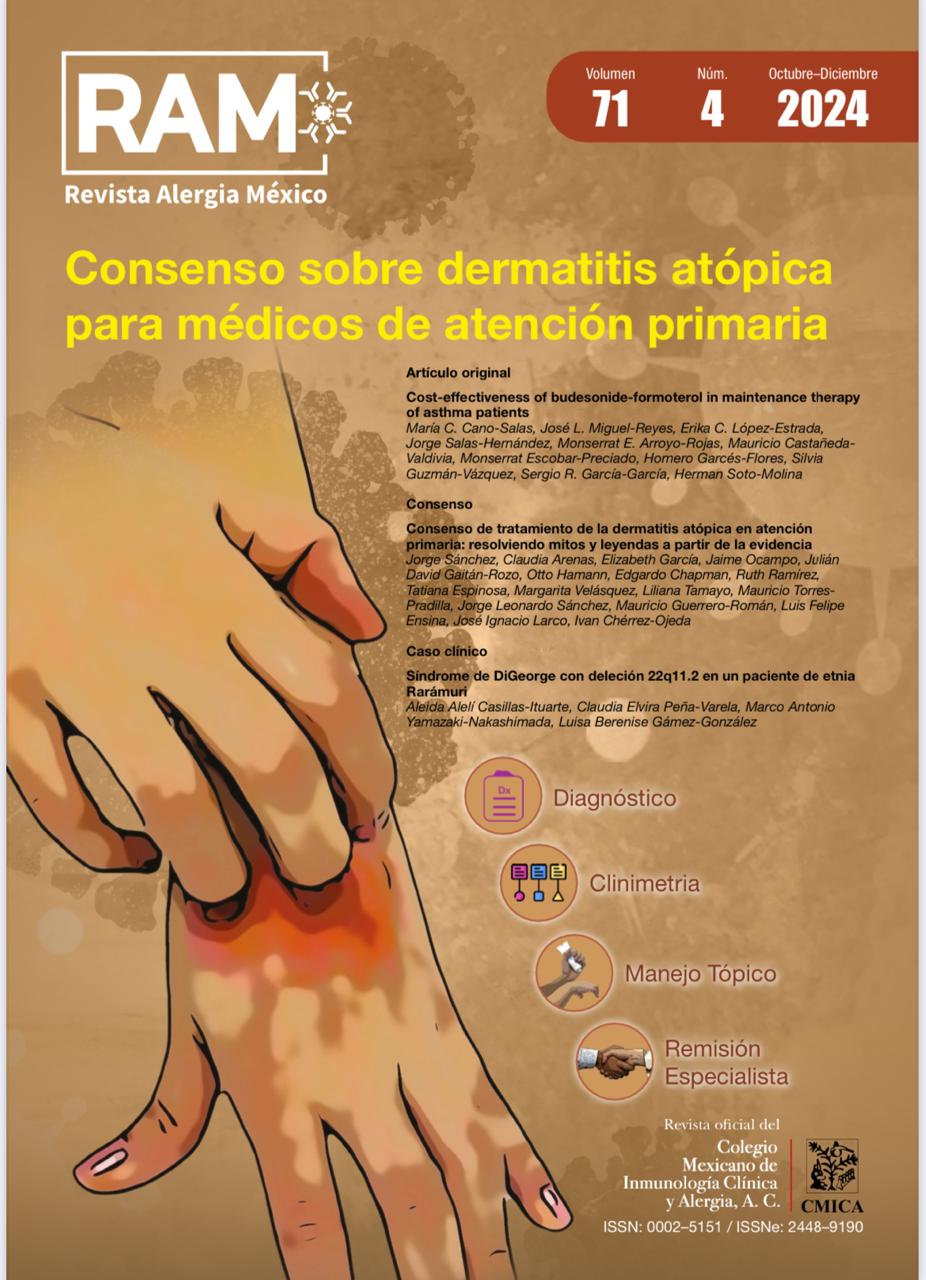Resumen
Objetivo: Elaborar un algoritmo de tratamiento en pacientes con alergia a la penicilina.
Métodos: Estudio retrospectivo, efectuado en pacientes adultos con alergia a la penicilina, que permanecieran en el grupo 3 o 4 de la clasificación establecida, y asistieron a consulta ambulatoria en el Departamento de Neumología y Alergia del Hospital Central del Instituto de Previsión Social, entre enero de 2021 y diciembre de 2022. A cada paciente se realizó una prueba de provocación con amoxicilina, previo consentimiento informado.
Resultados: Se registraron 60 pacientes, a quienes se logró eliminar el rotulo de alergia a la penicilina y a quienes se corrigió su historia clínica, con beneficios financieros para el paciente y el servicio de salud de Paraguay.
Conclusión: Las etiquetas de alergia a la penicilina pueden suponer una prescripción irracional de antibióticos, estancia hospitalaria prolongada y mayor necesidad de consulta. La estratificación del riesgo, solo por características históricas, es capaz de identificar de manera segura a los pacientes ideales para las pruebas de desafío directo. Este estudio demuestra la viabilidad del primer programa de desetiquetado de penicilina aplicable en un entorno ambulatorio, que puede realizarse incluso fuera de los servicios de alergia de los hospitales.
Palabras clave: Alergia; Alergia a la penicilina; Amoxicilina; Paraguay; Estratificación de riesgo; Viabilidad; Prescripción de antibióticos.
Referencias
Yilmaz R, Yuksekbas O, Erkol Z, Bulut ER, et al. Postmortem findings after anaphylactic reactions to drugs in Turkey. Am J Forensic Med Pathol 2009; 30: 346-349.
Jerschow E, Lin RY, Scaperotti MM, McGinn AP. Fatal anaphylaxis in the United States, 1999-2010: temporal patterns and demographic associations. J Allergy Clin Immunol 2014; 134: 1318-1328.
Albin S, Agarwal S. Prevalence and characteristics of reported penicillin allergy in an urban outpatient adult population. Allergy Asthma Proc 2014; 35: 489-494.
Picard M, Bégin P, Bouchard H, et al. Treatment of patients with a history of penicillin allergy in a large tertiary-care academic hospital. J Allergy Clin Immunol Pract 2013; 1: 252-257.
Powell N, West R, Sandoe JAT. The impact of penicillin allergy de-labelling on the WHO AWaRe antibiotic categories: a retrospective cohort study. J Hosp Infect 2021; 115: 10-16.
Baxter M. Bethune C. Powell R. Morgan M. Point prevalence of penicillin allergy in hospital in patients. J Hosp Infect 2020; 106: 65-70.
Steenvoorden L. Bjoernestad E.O. Kvesetmoen T.-A. Gulsvik A.K. De-labelling penicillin allergy in acutely hospitalized patients: a pilot study. BMC Infect Dis 2021; 21: 1083.
Macy E, Ngor EW. Safely diagnosing clinically significant penicillin allergy using only penicilloyl-poly-lysine, penicillin, and oral amoxicillin. J Allergy Clin Immunol Pract 2013; 1: 258-263.
Harandian F, Pham D, Ben-Shoshan M. Positive penicillin allergy testing results: a systematic review and meta-analysis of papers published from 2010 through 2015. Postgrad Med 2016; 128: 557-562.
Solensky R, Earl HS, Gruchalla RS. Clinical approach to penicillin-allergic patients: a survey. Ann Allergy Asthma Immunol 2000; 84: 329-333.
Hersh AL, Shapiro DJ, Zhang M, Madaras-Kelly K. Contribution of penicillin allergy labels to second-line broad-spectrum antibiotic prescribing for pediatric respiratory tract infections.Infect Dis Ther 2020; 9: 677-681.
Wolfson A.R. Mancini C.M. Banerji A. et al. Penicillin allergy assessment in pregnancy: safety and impact on antibiotic use. J Allergy Clin Immunol Pract 2021; 9: 1338-1346.
Blumenthal KG, Ryan EE, Li Y, Lee H, Kuhlen JL, et al. The impact of a reported penicillin allergy on surgical site infection risk. Clin Infect Dis 2018; 66: 329-336.
Blumenthal KG, Lu N, Zhang Y, Li Y, et al. Risk of meticillin resistant and in patients with a documented penicillin allergy: population based matched cohort study. BMJ 2018; 361k2400.
Jeffres MN, Narayanan PP, Shuster JE, Schramm GE. Consequences of avoiding β-lactams in patients with β-lactam allergies. J Allergy Clin Immunol 2016; 137: 1148-1153.
Kaminsky LW, Dalessio S, Al-Shaikhly T, Al-Sadi R. Penicillin allergy label increases risk of worse clinical outcomes in COVID-19. J Allergy Clin Immunol Pract 2021; 9: 3629-3637.
Sacco KA, Bates A, Brigham TJ, Imam JS, Burton MC. Clinical outcomes following inpatient penicillin allergy testing: a systematic review and meta-analysis. Allergy 2017; 72: 1288-1296.
Stone CA, Trubiano J, Coleman DT, Rukasin CRF, Phillips EJ. The challenge of de-labeling penicillin allergy. Allergy 2020; 75: 273-288.
Torres MJ, Adkinson NF, Caubet JC, et al. Controversies in drug allergy: beta-lactam hypersensitivity testing. J Allergy Clin Immunol Pract 2019; 7: 40-45.
Ortega-Cistneros M, et al. Alergia a penicilina. Art Rev. Rev Alergia Méx 2022; 69 (Supl l); 81-93.
Warner JO, Kaliner MA, Crisci CD, Del Giacco S, et al. Allergy practice worldwide: a report by the World Allergy Organization Specialty and Training Council. Allergy Clin Immunol Int–World Allergy Org Journal 2006; 18: 4-10; and Int Arch Allergy Immunol 2006; 139(2): 166-74.
Powell N, Honeyford K, Sandoe J. Impact of penicillin allergy records on antibiotic costs and length of hospital stay: a single-centre observational retrospective cohort. J Hosp Infect 2020; 106: 35-42.
Trubiano JA, Vogrin S, ChuaKYL, et al. Developmentandvalidationofa penicillin allergy clinical decision rule. JAMA Intern Med. 2020; 180 (5): 745-752. doi: 10.1001/jamainternmed.2020.0403

Esta obra está bajo una licencia internacional Creative Commons Atribución-NoComercial 4.0.
Derechos de autor 2024 Revista Alergia México





